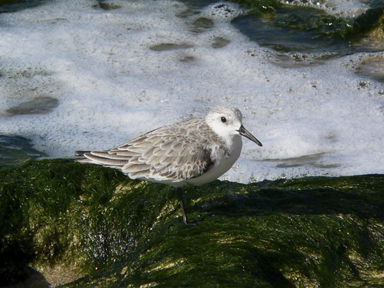Published in the Ocean Watch column, Honolulu Star-Advertiser © Susan Scott
January 27, 2014
Hawaii’s Pacific golden plovers, or kolea, get a lot of attention because they graze on lawns, have adapted to the presence of people and return to the same spot year after year. These wonderful birds give us Hawaii residents memorable native wildlife experiences right in our own backyards.
But kolea are just one of the common migratory shorebirds that visit the islands in winter. The others might not dance on our doorsteps, but we don’t have to go far to find them, either.
 Sanderling at Laniakea.
Sanderling at Laniakea.
Courtesy Scott R. Davis
A morning beach walk on a winter’s day often reveals little sanderlings either alone or in small groups. At 8 inches long, head to tail, the sanderling is so small it’s easy to overlook. This cutest of Hawaii’s shorebirds is also easy to miss because its colors match its favorite hangout, the edge of breaking waves.
The mottled gray and white shorebird’s Hawaiian name, hunakai, means sea foam. The birds are experts at following receding waves while snatching exposed invertebrates and then running up the beach ahead of the next breaking wave.
Hunakai often race ahead of the incoming water so fast that their short, black legs are a blur, and if a wave outruns them, they use their wings for a vertical escape. It’s at this time we might hear the call of the hunakai, a short sharp whistle that sounds like “Quit!”
Another common shorebird that I usually hear before I see is the well-named wandering tattler. The Hawaiian name of this bird, ulili, sounds like its call. These 11-inch-long, mostly gray birds usually forage alone on rocky beaches, and like the other shorebirds leave Hawaii in spring to nest in the Arctic tundra.
Ruddy turnstones, the fourth common shorebird wintering in Hawaii, are the easiest to spot. At 9 inches long, ruddy turnstones aren’t much bigger than sanderlings, but these visitors tend to forage in flocks, and their lovely orange, brown, black and white feathers are the colors of calico cats.
And, yes, in their search for food, ruddy turnstones turn stones.
It’s easy to tell sanderlings from Hawaii’s other common shorebirds because sanderlings are the only wave-chasers. But look closely.
“Would you like me to take your picture with the surf?” a nice man on the beach said last week when he saw me aiming my camera toward the big, beautiful waves breaking on the beach.
“No, thanks,” I said. “What I’m trying to shoot is a picture of this bird.”
“Bird?” he said. “What bird?”